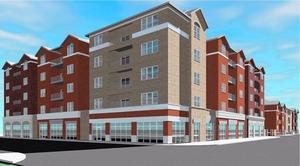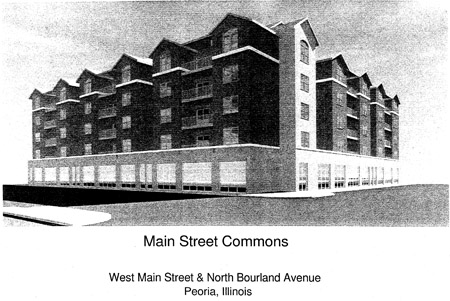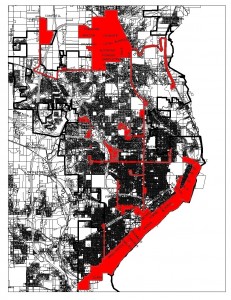 More residential parcels will become parking lots for the Main Street Commons development following the City Council’s 8-2 vote Tuesday night. The student apartment complex at Main Street and Bourland Avenue was granted approval to add 32 more apartment units to the existing 88 units and nearly double the number of off-street parking spaces from 97 to 182.
More residential parcels will become parking lots for the Main Street Commons development following the City Council’s 8-2 vote Tuesday night. The student apartment complex at Main Street and Bourland Avenue was granted approval to add 32 more apartment units to the existing 88 units and nearly double the number of off-street parking spaces from 97 to 182.
The plan, which violates the letter and spirit of the Land Development Code, was agreed to by City staff, the Zoning Commission, and the majority of the City Council. The plan was opposed by the University East Neighborhood Association and council members Akeson and Sandberg.
And they say Peoria isn’t “business friendly.” The Zoning Commission approved the plan even though the developer stood in front of them and admitted that he didn’t respond to the neighborhood association’s request to have him explain his plan to them. Second district council member Barbara Van Auken, who is seeking reelection next spring, made the motion to approve on the Council floor in spite of opposition to the project from the neighbors she represents.
Whither the West Main Form District?
What’s especially disappointing about this latest addition to Main Street Commons’ special use permit is that this project is set in one of the City’s four form districts — areas with very specific form-based codes. Form-based codes are used to combat urban sprawl — to proscribe built environments like the very one being created by Main Street Commons. This code was put together following a long process of public involvement and the inclusion of all stakeholders in the area.
But form-based codes only work if they’re followed. In this case, certain limits within the code have been consistently overridden by the Zoning Commission and the Council to the detriment of the neighborhood.
The buildings that front Main Street, according to the code, can be up to 5 stories tall, but as you move away from Main Street and into the adjoining neighborhood, the building mass is supposed to diminish. The code permits structures to be built along Bourland (going north from Main) to be 2-3 stories high and have frontage that does not extend further than 130 feet. The structure the council is allowing will be 4 stories high and extend 200 feet. This does not sufficiently taper the building mass into the neighborhood.
Another purpose behind the limits on building mass is to provide enough room on and around the block for parking. By increasing the mass of the building, additional parking needs are generated, and that has led to the razing of houses in the adjoining neighborhood to make way for surface parking lots. As of Tuesday night, two more parcels were added for conversion to surface lots. This again violates the letter and spirit of the code. Two of the goals of the parking requirements are to “reduce fragmented, uncoordinated, inefficient, single-purpose reserved parking,” and, “avoid adverse parking impacts on neighborhoods adjacent to the form districts.” This special use does just the opposite.
The code also requires alleys, but in a subsequent vote the Council vacated the existing alleys in the block being developed by Main Street Commons.
In short, the Land Development Code was once again eviscerated, treated like it doesn’t exist. The protections for neighborhoods were overruled and a development that could have been a welcome addition and stabilizing force has instead turned into an encroaching, destabilizing force in the University East neighborhood because it’s being allowed to grow unchecked by the very public bodies that are supposed to be representing the residents of Peoria.
Salt Lake City takes a different, better approach
The very same night the Peoria City Council voted to allow houses in an urban neighborhood to be razed to make way for a surface parking lot, the City Council in Salt Lake City, Utah, banned demolishing buildings to create parking lots. Furthermore, they are considering an ordinance that “would require property owners to keep vacant buildings and houses ‘habitable’ — fit to live or work in. It would allow for demolition only after a property owner submits plans for a replacement structure and obtains a building permit.”
Why? Because they recognize that just razing buildings does not stabilize an area. Take a look on the South Side or East Bluff in Peoria. There are lots of empty lots where houses have been razed. But has that really helped the neighborhood? There are certainly some advantages to such a strategy if the property was an eyesore, safety hazard, or haven for drug dealers. But ultimately, replacing run-down structures with vacant lots (often weed-infested) and surface parking do nothing to increase property values or attract new people to the neighborhood. Urban neighborhoods with multiple missing houses look like a smile with missing teeth: not attractive.
It’s a shame more progressive policies against blight can’t be enacted — and enforced — here in Peoria. It’s a shame we don’t enforce the existing policies that residents already worked so hard to enact.
A person in the City Council gallery Tuesday, frustrated with the Council on another issue that affects a neighborhood in the third district, asked rhetorically if the City Council represents the residents or the developers. I think we all know the answer to that question.

 The Bradley Scout has been doing a good job of following the progress on Main Street Commons, the apartment building that is being erected on the site of the old Walgreen’s on Main Street, across from Campustown. The project was originally sold to neighbors as an upscale apartment building for upperclassmen, graduate students, and young professionals. They also optimistically predicted that they would have 100% of the units leased by November 1, 2010.
The Bradley Scout has been doing a good job of following the progress on Main Street Commons, the apartment building that is being erected on the site of the old Walgreen’s on Main Street, across from Campustown. The project was originally sold to neighbors as an upscale apartment building for upperclassmen, graduate students, and young professionals. They also optimistically predicted that they would have 100% of the units leased by November 1, 2010.  It was
It was 